“At Flores, in the Azores Sir Richard Grenville lay
And a pinnace, like a
‘Spanish ships of war at sea! We have sighted fifty-three!’ “
— Alfred Lord Tennyson, The Revenge, A Battle of the Fleet
The last week in September seemed the ideal choice for our family break in Devon. The weather gods were being kind, for a change and, as our holiday drew closer, visions of an Indian summer in the West Country swayed seductively before us. Then came the rain!

Before departure, I spend more time preparing my photographic gear than I do on such lesser matters as clothes and shoes. My wife regards this as yet another of my many eccentricities but I am hopeful that Macfilos readers will more readily empathise with me. For the anticipation of a family holiday accompanied by my camera is happiness indeed.
Our accommodation for the week was a house on the Western end of Dartmoor, near Lydford, just a few miles from the charming market town of Tavistock. My anticipation, however, had not featured rain.
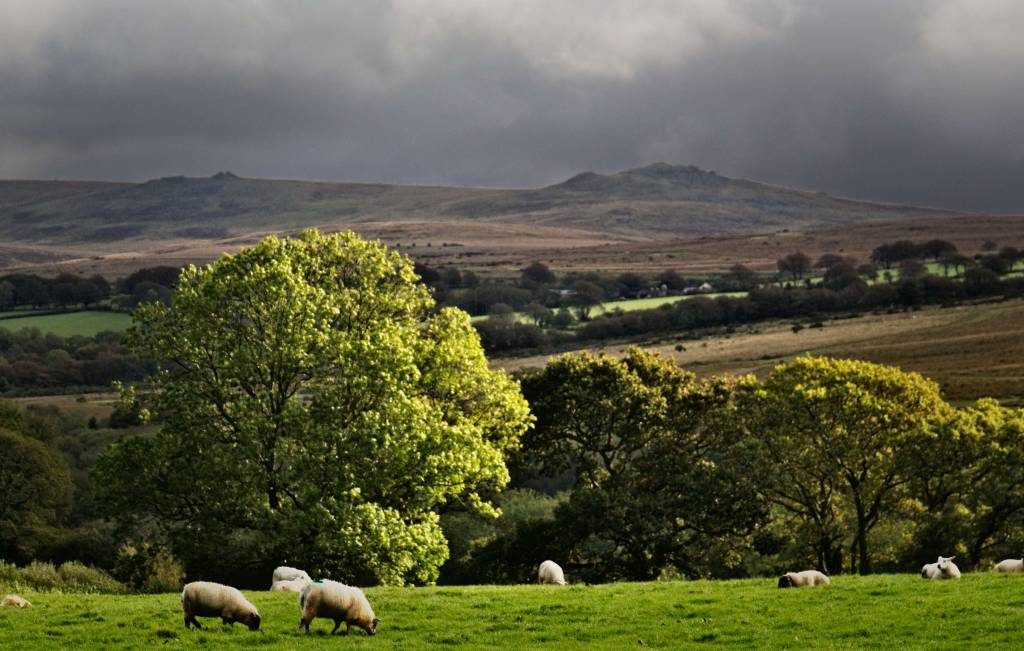
Gear break
First, though, a word about the gear I took with me. It deserves a sentence or two since I spent so much time in advance fettling the outfit. My trusty Fuji X-T2 with battery grip had the Fujifi
I also took along the 2x teleconverter as well for some long landscape shots across Dartmoor and it remained in use throughout the week. Of course, my Fuji X-T20 came along too but is now no longer attached to my much-loved Fujifilm XF16mm f/1.4 R WR.
You should know that recently I traded in this truly excellent lens for a new acquisition the Fujifilm XF 10-24mm f/4 R OIS zoom. I expect there will be some sharp intakes of breath at such wild folly from prime lens aficionados everywhere. But the deed is done. I have long been a prime enthusiast myself but I now want a more flexible wide-angle capability. And keeping both lenses was not an option. I shall be evaluating this new (to me) lens in due course but, meanwhile, I am including my first efforts with it later in this article. Then came the rain!
Don’t mention the rain
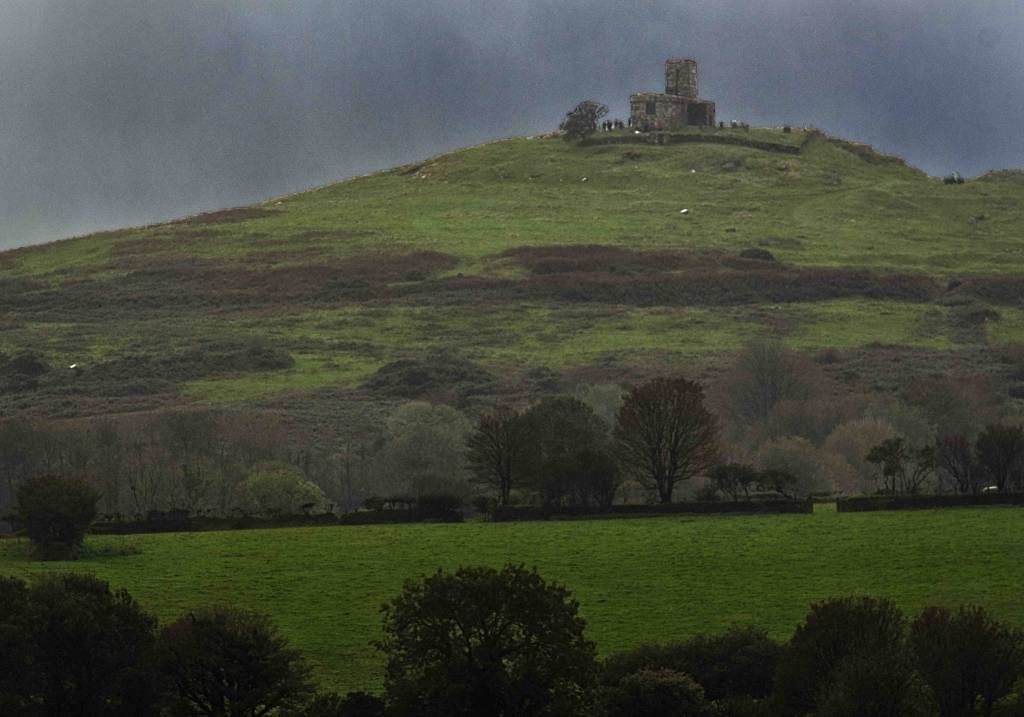
Have I mentioned already that we had a lot of rain during our week’s holiday? To be fair, we did have one utterly glorious day and two other pretty good half-days but that was it. The rest of the time was indeed mixed: Sometimes wet, sometimes very wet and sometimes very, very wet.
And yet, that is not the whole story. For a start, wet has its own charm and so I took some images in the rain. This is not my usual choice but it took me out of my comfort zone. More importantly, there are of course great light variations before, during and after a rain shower.

Comparing the two images above of the Church of St Michael, D7 was taken in steady rain while D19 in the sun is quite a different shot.
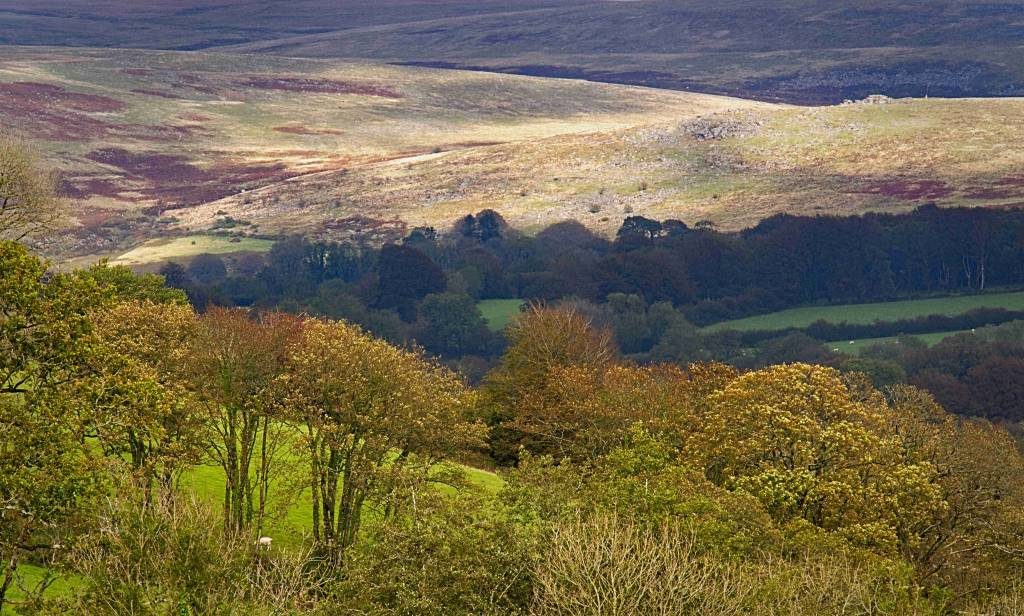


The Grenvilles
During the week, I wanted to visit some places connected with the Grenville family whose history I have been researching with a possible book in mind. It is one of this country’s most illustrious families as I will explain later.
We decided to visit Bideford in Devon, and Kilkhampton, just over the border in Cornwall, since both locations were intimately connected with the Grenvilles. The house at Stowe no longer exists (its building materials were incorporated into other houses in the 18th century). It made sense therefore to visit the nearby church at Kilkhampton which was the place of worship nearest to Stowe.
Over the years here are many variations of the spelling of the family name: Grenvilles, Grenviles, Grenfells, Greynvills, Graynfelds, Greenfields, Grenefelds, Grauntvilds. I shall standardise on Grenvilles.
The Grenville family can be traced back with certainty to the reign of King Henry II (1154-1189) when a Grenville held half a knight’s fee in Bideford. By 1166 a Richard de Grenville is holding three knight’s fees and a half in Devon and Cornwall. For the next three centuries, Grenvilles held the manors of Bideford in Devon and Stowe, near Kilkhampton in Cornwall, living, for the most part, the lives of worthy county gentry while keeping the King’s peace as Justices for Devon and Cornwall.
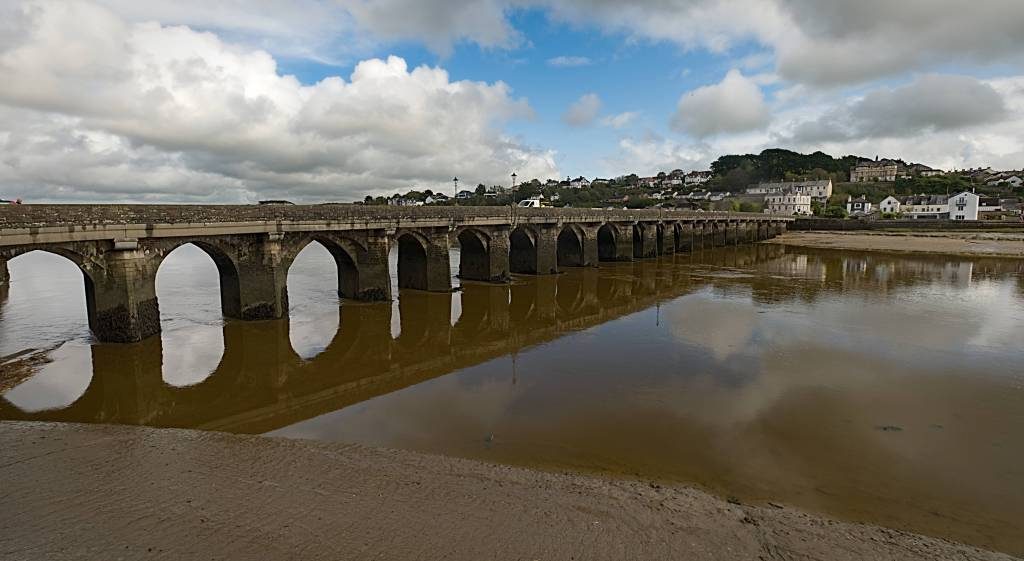
The first bridge at Bideford across the Torridge river estuary was built out of wood in the last quarter of the thirteenth century. It was one of the longest mediaeval bridges in the country and had arches of unequal sizes for reasons which are not entirely clear.
But perhaps it was to cater for differing sizes of ships. However, when Sir Theobald Grenville (1343-1381) financed a stone replacement bridge in the fourteenth century, it was constructed by using the old wooden bridge as scaffolding, with the result that the stone bridge faithfully reproduces the inequalities of the original.
It is also probable that the siting of the bridge (original and replacement) was due to its close proximity to the Grenville manorial land in Bideford. The Torridge river is equally wide for hundreds of yards at this point, with no obvious narrow point.
Lord Chancellor
One notable high-flier among the mediaeval Grenvilles was William Grenville (or Greenfield), who was Lord Chancellor of England from 1302 to 1305 in the reign of Edward I, and then, Archbishop of York from 1305 until his death in 1315, under Edward I until his death in 1307 and thereafter under Edward II.
This combination of one man holding high office in both State and Church successively was not uncommon at the time, for the solid reason that the clergy were usually the best
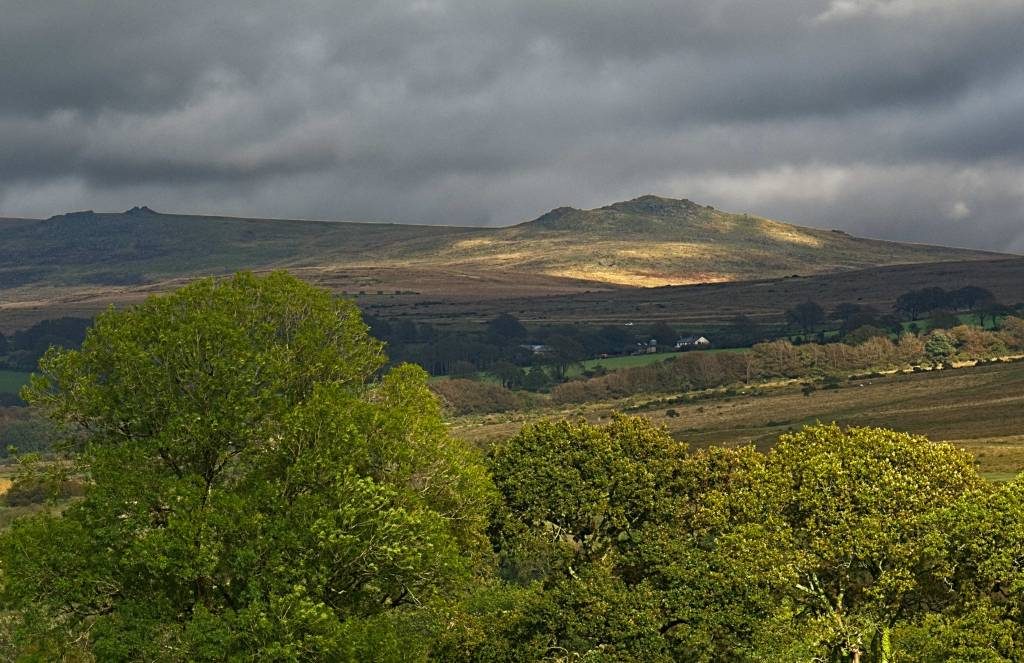
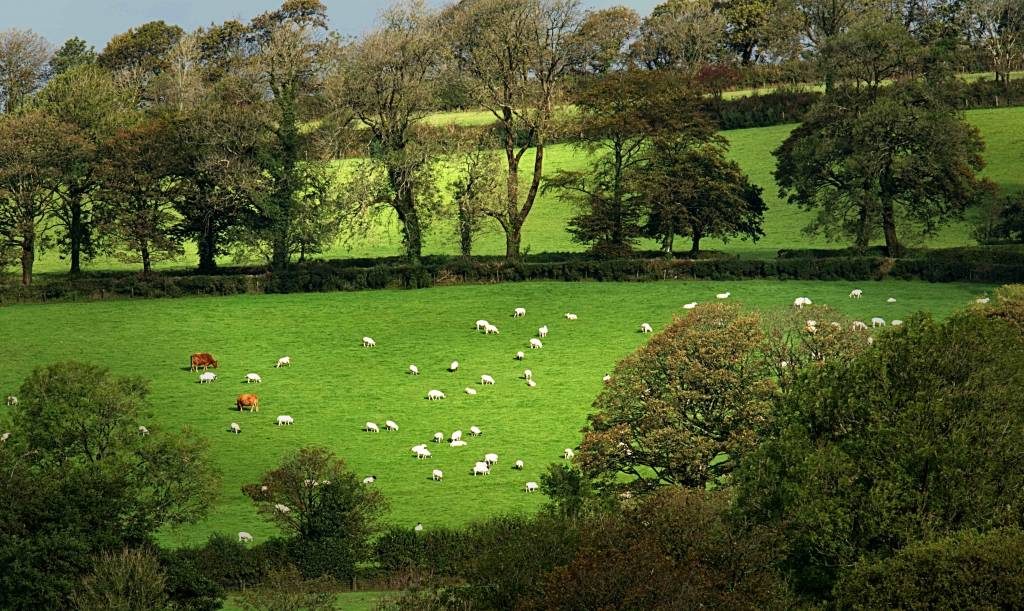
The next Grenville of note was Sir Thomas Grenville (1449 – 1514),
When Henry VII came to the throne in 1485, Thomas was rewarded for his support by the new king and was made Esquire to the Body, as well as Sheriff of Cornwall, and later, in 1501, he was made a Knight of the Bath.
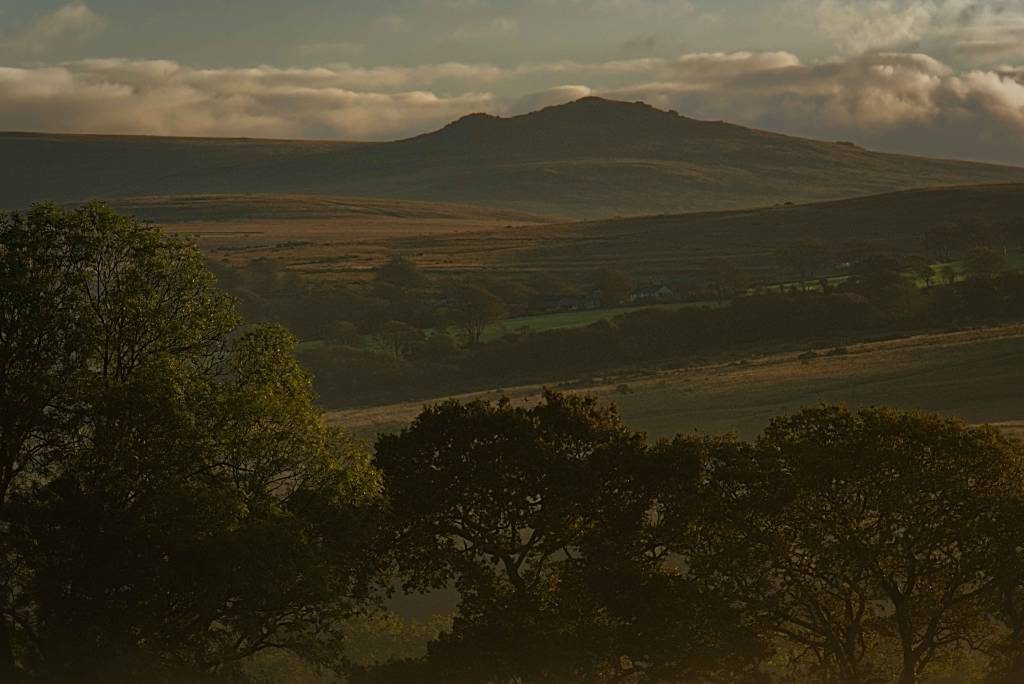
Honorable mention
I am particularly interested in the life of one of Sir Thomas Grenville’s daughters, Honor, who was probably born at Stowe House, Kilkhampton, in 1493 and died in 1566.
At the time of her father’s death in 1514, she was twenty years old and unmarried. Sir Thomas’s will charged to ensure that his eldest son Roger should see her married well and left money for her dowry. Roger fulfilled his obligations and in 1515 married Honor to Sir John Basset, another prominent Lancastrian supporter.
Sir John was wealthy, with many estates and two manors at Tehidy and Umberleigh, as well as having three daughters by his first wife. Sir John and Honor then produced a further three sons and four daughters in the eleven years of their marriage.

The high esteem in which Sir John held his wife, Honor, was demonstrated by the fact that on his death on 31 Jan 1528 he left her a life interest in all of his property and the management of his daughters including those by his first marriage,
But Honor had not finished her rise in the world. In 1529 she made a second marriage to a member of the extended royal family, to Sir Arthur Plantagenet, Viscount Lisle, who was the illegitimate son of Edward IV and therefore half-uncle to Henry VIII. Despite his Plantagenet blood, Arthur was not considered a threat by Henry VIII because of his illegitimacy. In fact, the king had long trusted Arthur and had made him a Gentleman of the Privy Chamber, a Privy Councillor and Vice-Admiral in 1525.

Calais posting
Early in 1533, Henry VIII appointed Arthur Plantagenet to be King’s Deputy in Calais. It was a much more important role than it sounds because Calais, together with 120 square miles of the surrounding country, was England’s last remnant of continental possessions.
Furthermore, all diplomatic visitors to England passed through Calais on their way to London and conversely returned via Calais at the end of their visit. The King’s Deputy in Calais was therefore responsible for meeting, entertaining and obtaining information from all such royal and diplomatic travellers in order to further the king’s diplomacy.

Honor had already visited Calais the year before her husband was made King’s Deputy there. In October 1532 she was one of six ladies chosen to accompany Anne Boleyn, the new Queen, to Calais to meet King Francis I of France. Henry VIII was eager to obtain Francis’s seal of approval for his new Queen, including his support against the Pope in the ongoing dispute over his divorce from Catherine of Aragon.
Honor had danced with the King of France, wearing a set of jewels said to be worth £100,000. All quite some achievement for the daughter of modest gentry stock.
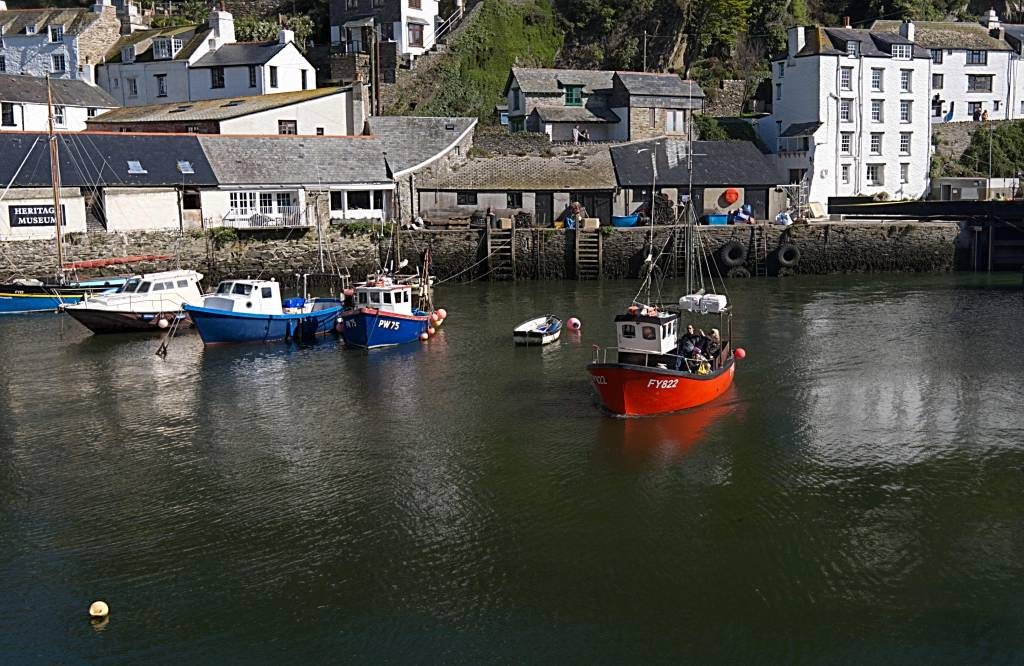
In the Tower
The King had come to believe that Arthur Plantagenet had been plotting against him and accordingly had him imprisoned in the Tower. At the same time, Henry VIII ordered that all the Lisle’s correspondence since 1533 should be seized, as well as that of anyone else who had corresponded with them. In all, three thousand letters were gathered as potential evidence to be used in the trial of Arthur Plantagenet, Lord Lisle.
After two years, Henry VIII realised that the grounds upon which he had imprisoned his half-uncle were baseless and commanded his release. This glad news was so overwhelming for Arthur that he had a heart attack and died that night.

It is believed that Honor, Lady Lisle, heard of her husband’s pardon before she heard of his death which must have been very hard. She retired to Umberleigh, one of her Basset homes, with two of her daughters, Mary and Philippa.
After that, little is known of Honor’s life beyond two instances. In 1556, she had her income increased by £120 a year when the Lisle’s suit in Chancery for some lands was settled in her favour. Secondly, in 1558, Honor and Arthur’s grandson, also Arthur, made a deal with George Basset, his uncle, in which Arthur acquired Umberleigh with Tehidy going to Honor for life, afterwards reverting to George.
Honor died at Tehidy in 1566 and was buried in Illogan church nearby.
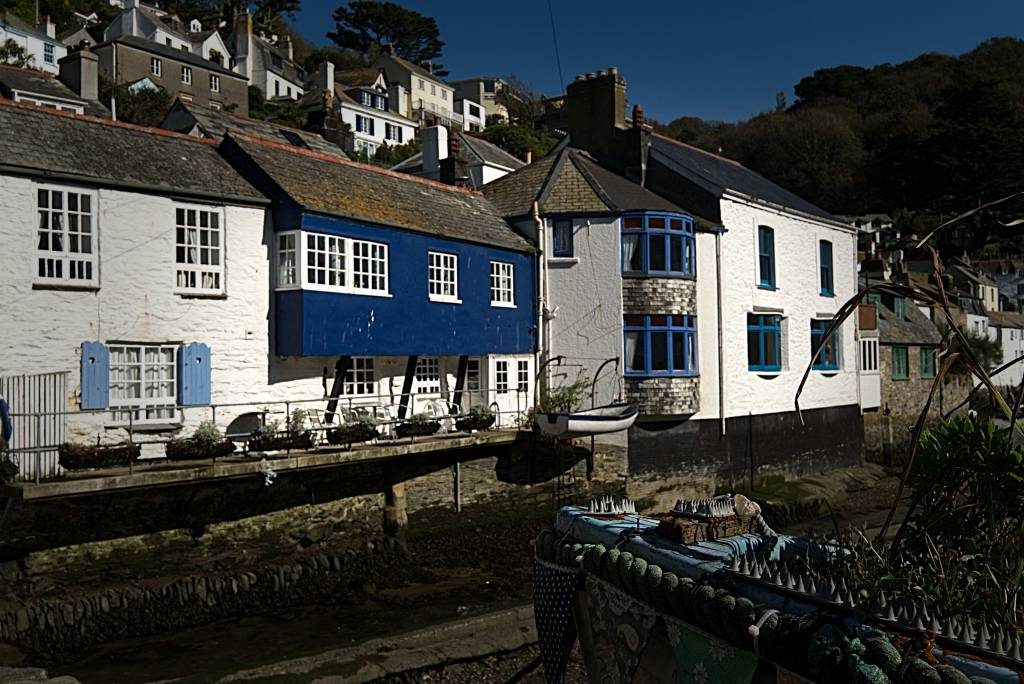
3,000 letters
Thanks to Henry VIII’s mistaken belief in Arthur Plantagenet’s treasonable activities, the three thousand Lisle letters are readily available. I have started reading them but may be some time on this task.
On Sir Thomas Grenville’s death in 1514, he had willed to his younger son, John, “if he be disposed to be a priest, to have the next avoidance of one of the benefices of Bideford or Kilkhampton”. John had indeed become a priest and, accordingly, in 1524 became the Rector of St James the Great in Kilkhampton where he remained until his death in 1580.
This stability of service was outstanding in an era of astounding change. John weathered all the changes of the Reformation, a period of conspiracies, religious conflict and executions.
He served seven Bishops of Exeter, both Catholic and Protestant, as well as four sovereigns: Henry VIII, Edward VI, Mary and Elizabeth I (not forgetting Lady Jane Grey, squeezed into nine eventful days between Edward and Mary). Kilkhampton church also has a Grenville chapel which contains Sir Bevill Granville’s monument. Above the screen are the arms of John Granville, First Earl of Bath.
Grenville of The Revenge
We now turn to Sir Richard Grenville of ‘The Revenge’. At Bideford, close to the quayside and Sir Theobald Grenville’s bridge, is a house with a plaque which celebrates the achievements of Sir Theobald’s Great, Great, Great, Great, Great Grandson as below:
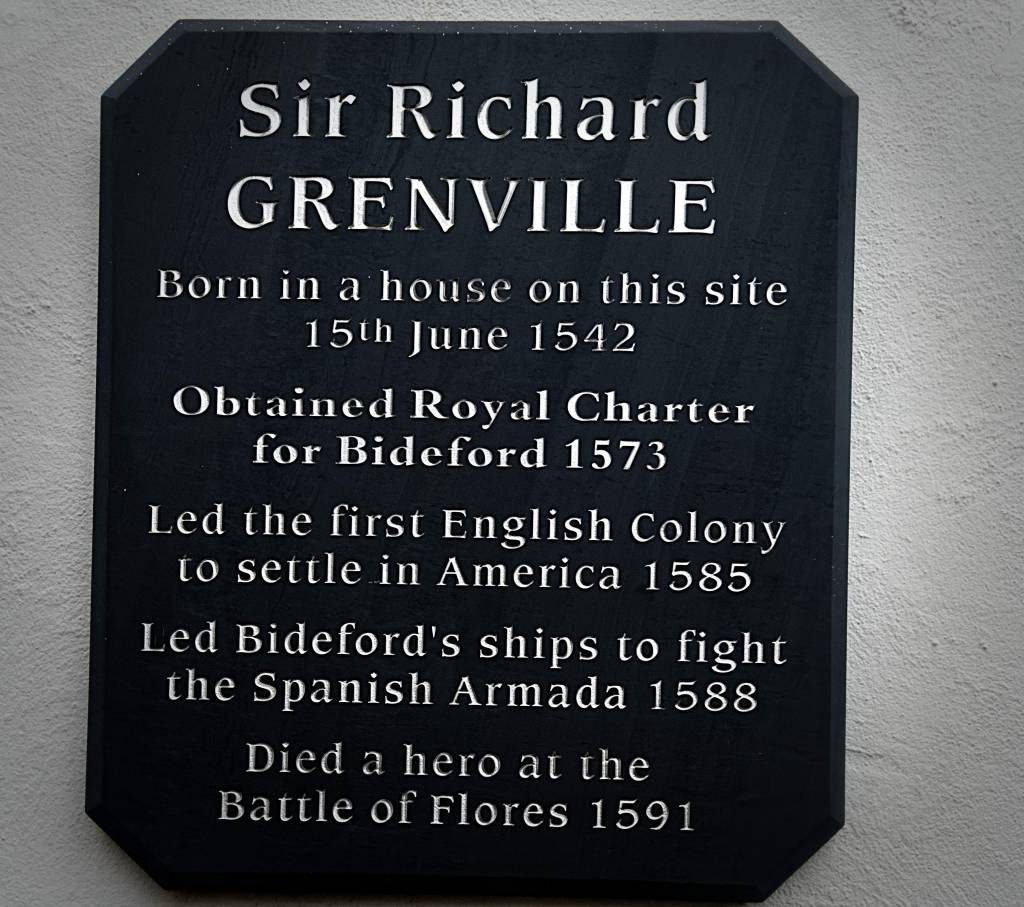
The house itself is today nothing special as none of the exterior of the original remains. However, the foundations and some interior walls still retain traces of the original house.

Richard Grenville was born in 1542, the son of Roger Grenville, but lost his father in a terrible maritime disaster. Roger Grenville was captain of the Mary Rose, Henry VIII’s flagship, which keeled over in the Solent in 1545 and water rushed in through her open, lower gun-ports. Richard Grenville grew up to be one of the great sixteenth-century heroic adventurers being a soldier, an armed merchant fleet owner, a coloniser of the New World, an explorer and, on his ship ‘The Revenge’, an outstandingly courageous sea captain.
In the famous battle, Sir Richard Grenville, Vice Admiral of the Fleet under Sir Thomas Howard, with his one vessel, fought a three-day battle against fifty-three Spanish ships, succeeding in sinking some and badly damaging many others. ‘The Revenge’ was boarded three times but each time the Spanish were repulsed. ‘The Revenge’ was ultimately overpowered and Sir Richard Grenville died of his injuries shortly after capture. He was however honoured by his Spanish captors in light of the heroic action against overwhelming odds.
Alfred, Lord Tennyson, wrote a famous poem about the Battle of Flores and Sir Richard Grenville’s heroic action in which he pitted ‘The Revenge’ against the Spanish fleet.
I recommend that anyone who does not know about Sir Richard Grenville should read this short ballad as it is readily available online. The first three lines are:
“At Flores, in the Azores Sir Richard Grenville lay
And a pinnace,
We should also mention Sir Richard Grenville’s grandson Sir Bevil Grenville (1596 – 1643) who was a brave leader of Cornish soldiers in War. He died in the Battle of Lansdown,
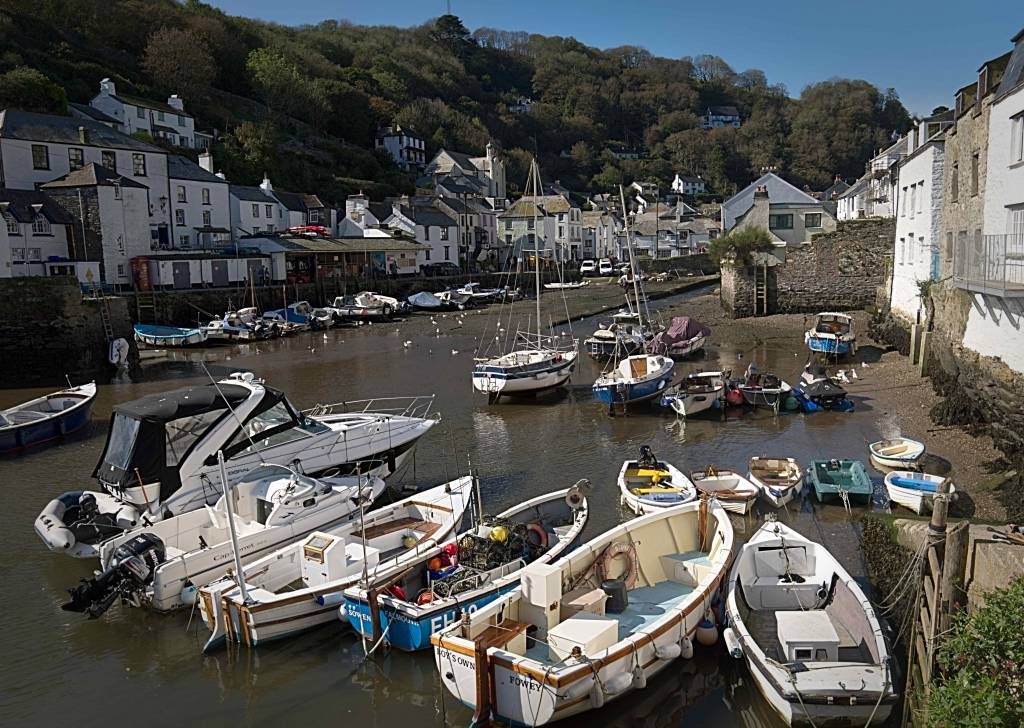
There are several further notable Grenvilles whom I haven’t covered in this article so it is fair to say that the family is one of the most illustrious in our history. It was inspiring to visit Bideford and Kilkhampton as well as to see much of the land in which they lived and worked. We certainly had a cracking holiday despite copious rain.
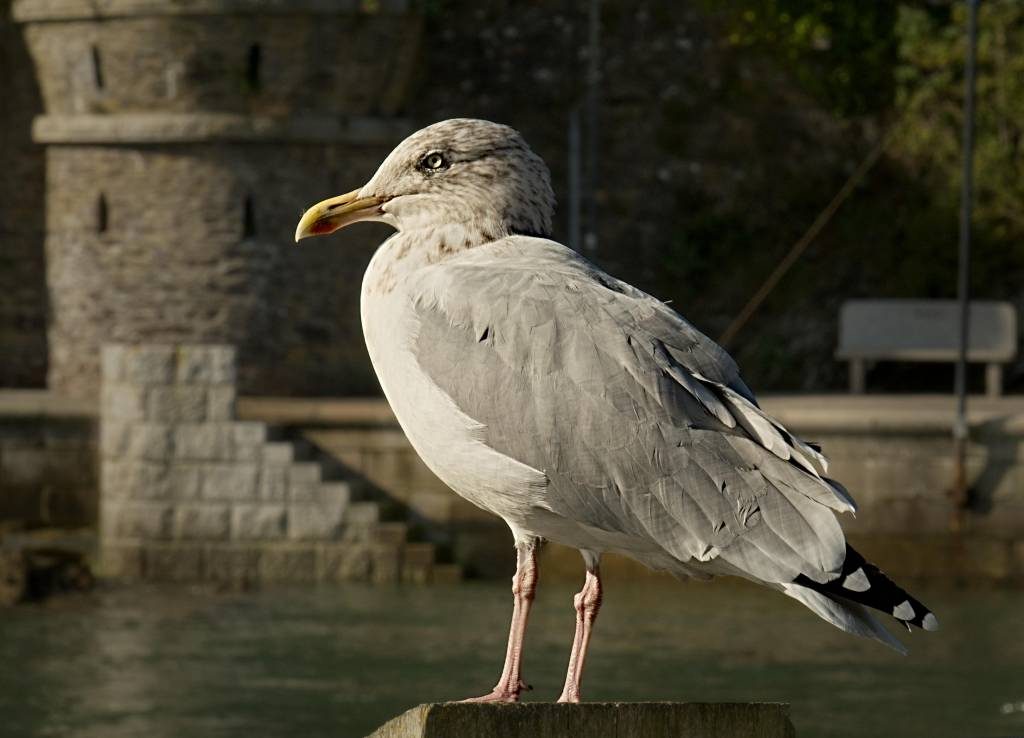
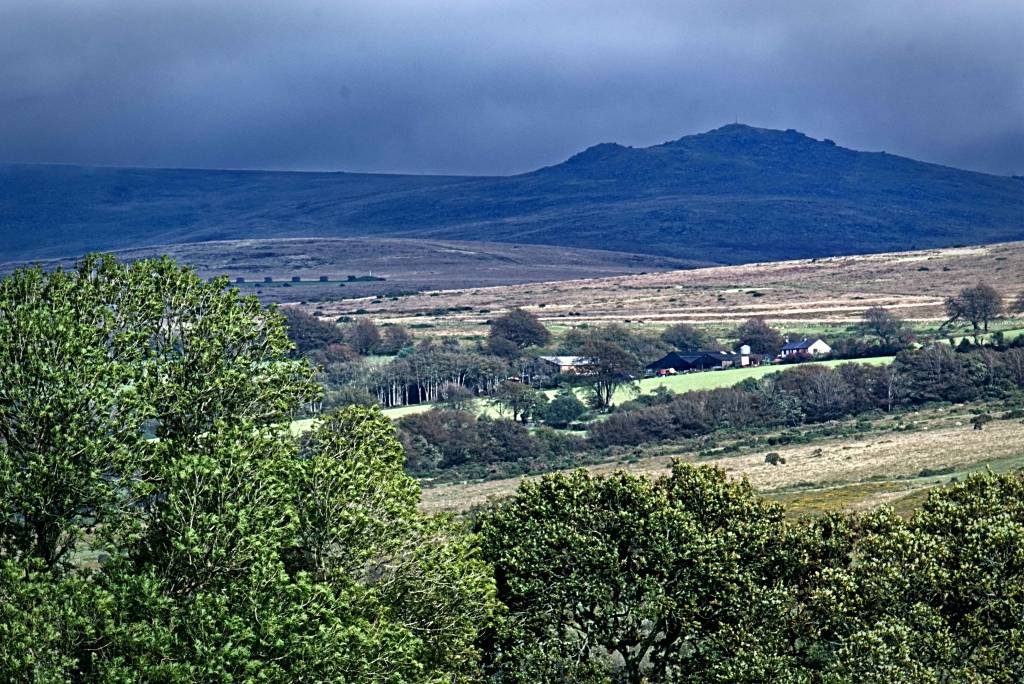
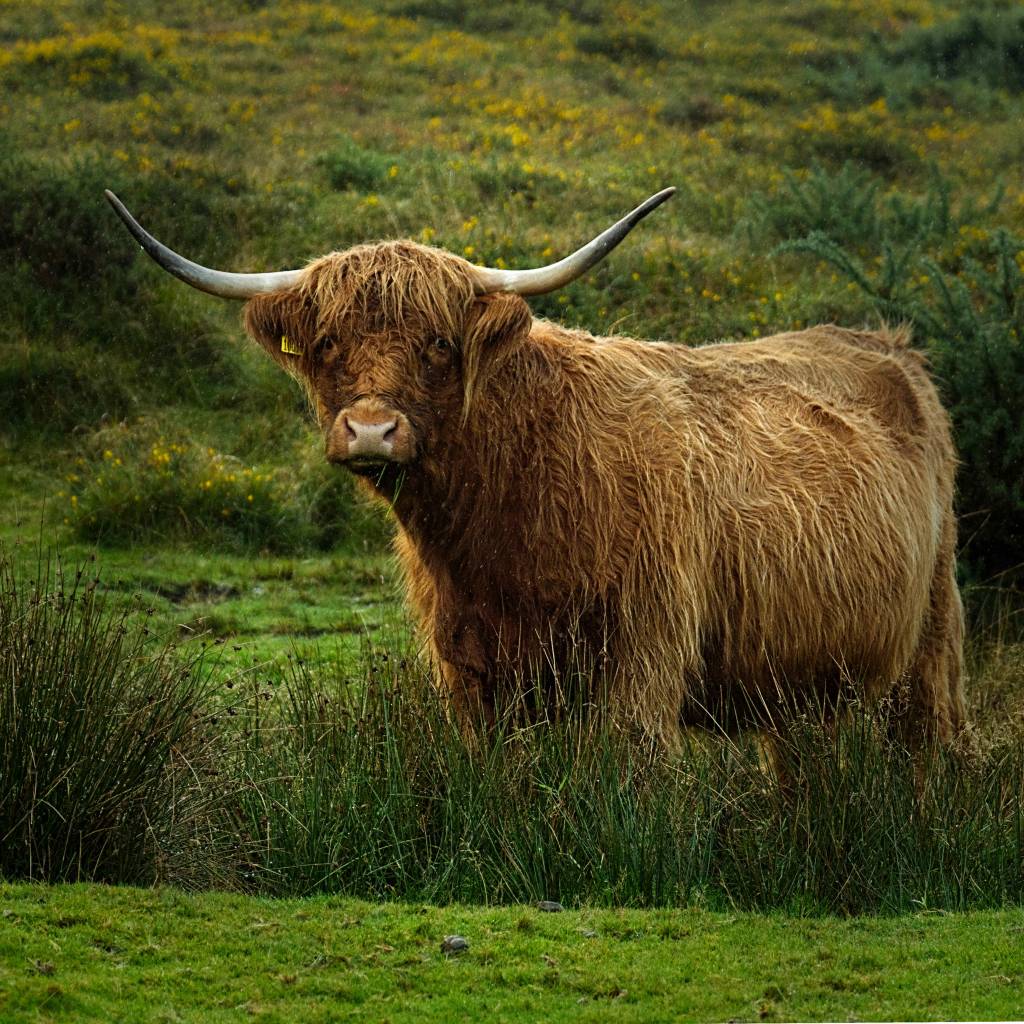
Subscribe to the Macfilos mailing list to receive one message at 8 pm London time from Monday to Friday with links to our latest articles. Your address will remain confidential and will not be used for any other purpose. Every email contains an unsubscribe link so you may cancel at any time. We hope you will join us in helping make Macfilos more popular and relevant to our readers.


I come from Devon and have lived in Australia for a long time now but still remember staying with my aunt on Dartmoor, those were wonderful times for me walking her dog over the moor and seeing the ponies.
I really enjoyed your photos especially your article on the Granville’s. I have been doing my family trees for over twenty years now, my mothers Dowdall family have several ancestors with Granville as a Christian name so I love reading about the early Granville’s.
Thank you so much
Margaret Gully originally from Torquay
Thank you, Margaret. Dartmoor is a beautiful place and I’m glad you have such happy memories. We took our black Labrador, Rose, with us and sometimes it was quite difficult to ensure she was out of frame!
Although I have done the research into the Grenvilles, it is my wife who is the real expert on family tree investigations for our family. The internet is a wonderful research tool as long as you double and triple check all one’s “facts”!
I do hope you are well away from the current problems of drought and fire. I have a friend in NSW, a farmer, who is suffering very badly from the drought and finding feed for his stock. Last week there was a bad fire just over the ridge from his farm.
Landscapes – Check. History – Check. Photography – Check. Old Country – Check. This is the kind of article I will likely read over and over again. Many thanks!
Your comment is heart-warming. I had been worried that my own deep interest in history had run away with me in this article. So pleased that you enjoyed it.
Jonathan,
Very much enjoyed the excellent images in your SL2 article which was also a cracking review though of course I have no actual Leica experience at all.
We have both recently tested our gear in challenging but very beautiful locations. I envy you the X-T3 but am holding off for the X-T4 next year.
Thanks your re-assurance re the wide angle zoom which I am beginning to like very much. Must though work at getting my images nearer to your standard.
We are going on a Hurtigruten ferry cruise up the Norwegian coast in early 2020. Should be a great chance for photography. I feel an article brewing!
Thanks all your comments
Thank you Dave
I can see why you’re waiting for the X-T4 (although I’m not sure what it can bring to the party). The Ferry cruise sounds wonderful – I’m envious! (although we’ll be off to the Italian Alps for a week in March).
And your images are great! Not just family snapshots (as Gary pointed out).
Look forwards very much to your Norwegian travels – and I can thoroughly recommend the 16-80 as a walk about weathersealed lens.
best
Jono
Hi There David
Great article ad lots of great pictures – we just came back from a similarly wet week in Cornwall – My X-T3 and the new 16-80 got a good dousing, but I did get some good shots. Most of the time was spent getting snaps for the SL2 article, but the Fuji is a great camera.
As for your swapping the 16mm to the 10-24 – sounds completely sensible to me. I’ve always read that wide angle lenses might just as well be zooms as it doesn’t detract from the optical qualities.
All the best
The old saying lives in you, “If you don’t know where you come from, you dont know where you going.” Magnificent journey, Fantastic photos, and Historythe way it should be taught in schools. Thank you for the ride!!!
Thank you John. I couldn’t agree more about history.
The definition of history I like comes from the historian and philosopher R G Collingwood who wrote:
“The value of history then is that it teaches us what man has done and thus what man is.”
I think this merely rephrases what you have said.
Lovely Fuji colours David. They are the best in the business at colours with their film background. Apologies for not replying earlier, but I was busy today writing two articles, including my next one for Macfilos. I like your history pieces above. A lot of our ancestors were Norman rather than Irish. The first known William Fagan came to Ireland with the Norman Invaders in 1169/1170. Their leader was a man called Richard de Clare, 2nd Earl of Pembroke, known as ‘Strongbow’. That William Fagan became a sort of ‘mayor’ in Dublin and built a Fagan’s Castle here. It no longer exists, but its location is marked on old maps. My name William actually comes from my mother’s family who were called Supple from the French ‘La Chapelle’, the word for a chapel or church. On my wife’s side, her father was named Butler, which is an obvious Norman name, means wine steward deriving from bouteille, the French word for a bottle. Only her mother, who was an O’Reilly, had a true Irish name. Our ancestors in the 12th Century probably spoke French rather than Irish or English, apart from the O’Reillys who would have spoken Irish.
William
Many thanks your comments, William.
Unsurprisingly I love Fuji colours too. It has not been easy however finding the right RAW converter to handle X Trans files. Lightroom long had major problems with converting RAF images although they have now caught up with their “Enhance Details” feature. But this was not designed for FUJI files alone and is processor intensive and very slow, not recommended for batch processing etc. Besides I won’t live with their subscription model!
I have always used Affinity Photo which handles Fuji files just fine but is only an editor and does not have digital management features.
I have just adopted Capture One Pro which has been thoroughly recommended by a good number of professional Fuji photographers. This does what Lightroom does only better and I am deligted. I shall still use Affinity Photo for selected images requiring more advanced editing.
I am so pleased that you enjoyed the history in my article since I had worried that I might have strayed too far from what people enjoy. Your Norman background information is fascinating and I shall have to find time to investigate further. English rule/interference in Irish history has been so unfortunate for both parties (more so for the Irish of course) that an understanding of Irish history is necessary to understand much of ours. For example Sir Richard Grenville was active in Ireland, see link to Wikipedia below, including involvement in land grabs, rebellions and other high handed deeds. I cannot advance him as a peacemaker! He did have friends however who protected his wife and daughter from capture.
forgot to put the link in, a senior moment!
https://en.wikipedia.org/wiki/Richard_Grenville#Activity_in_Ireland
I see that Grenville planned to attack the town of Youghal (pronounced ‘Yawl’) where my mother came from. Sir Walter Raleigh had lived in a house at the end of the street where my mother grew up. He was not that well liked by the locals for various reasons, but he was not as disliked as much as a later visitor called Oliver Cromwell. You can see the marks of Cromwell’s spurs on a box on which Cromwell stood to address his men in St Mary’s Collegiate Church just across the road from my mother’s house. The church is next door to Raleigh’s house, which was called Myrtle Grove. Close locational and family ties can make history seem much more real.
William
Grenville was a cousin of both Walter Raleigh and Francis Drake – an example of the network of close family relationship in the West Country in the C16th.
David
Really absorbing history. Like others, I’m also intrigued by your use of zoom for landscape. I must get out my ancient (in digital terms!) V-Lux 1 with its 400mm (equiv.) internal focussing zoom (no dust problems!) and try something different than I’ve previously used it for.
John, I find it very practical since it forces me to identify what is to be the subject and concentrate on that. Its an excellent aid to com position and I’m quite hooked by the whole proceeding and haven’t taken my teleconverter off the 50-140 for weeks!
However, there are of course many shots where this is the wrong combo and I am slowly falling in love with my new 10-24 wide angle zoom. Expect a lot of shots from this as I find my feet!
Goos luck with the V-Lux 1 and 400 lens!
Thanks David. I find the photos of Dartmoor beautiful, they remind me of my trips there with the Scouts. The first image of the trees is one I would like to frame and hang on a wall. I like the way the light in the background leads my eye around the picture. Although framing and hanging sound more like the troubles the Grenvilles would have had to endure!
Thank you, Kevin, for your comments.
The light on the trees in that first image was the only patch of sunlight at the time, with a very dark sky overhead. Fortunately I was so far away that the subject more or less filled my viewfinder and required little cropping.
I like your last remark about framing and hanging which certainly sounds a bit like being “hung, drawn and quartered.” Nowadays, we see a General Election as cruel and unusual punishment but our ancestors had to face much worse!
Thanks for a wonderful article. The historical information is quite fascinating and educational. There are so many compelling images that I cannot pick a favourite! You made very competent use of your telephoto to pick great landscape images. I absolutely love the Dartmoor Resident image. Thanks, Brian
Pleased you enjoyed the article and images, Brian.
The Dartmoor resident image was taken in persistent rain which didn’t bother him at all. Fortunately his coat has some lovely streaks and highlights of colours which have still come out well.
After this shot, I scuttled back inside for coffee and biscuits…….
Some great lighting in some (most) of these, David. Fuji colours really come to the fore with a little sunlight and contrast in a scene.
And great write up too.
Thank you Jason. The week emphasised to me that I am normally too unadventurous a photographer, perhaps too easily writing off a session because of less than perfect weather. The lesson must be I think to follow the light wherever it is and never mind for how short a time it is around. Photography has lots of lessons I think, part of its charm!
An excellent indication David, of the quality that Fuji gear can provide.
There’s a strength in the images that you present. A bit of post processing I guess? Do your shoot RAW or Jpeg?
Your early comment that the light is so important and a key factor in final output is very well illustrated.
Thank you for a great start to the day over here on the other side.
Wayne,
Good to have your comments.
Being a careful person, I shoot RAW plus Fine jpeg so that I have all the options. I know some say the ideal is to get it all right in camera so you don’t need to bother with RAW but I am not that good a photographer. RAWs save my bacon on several occasions.
So. my normal workflow, on images I rate as promising, is to use Capture One Pro for RAW conversion and some editing with Affinity Photo for more sophisticated work if necessary.
Each image has therefore been worked on but I hope this has not been to their detriment. As I see it the camera does not always record the totality of the image my eye sees. Modest work to close this gap in emphasising certain tonal variations or tweaking colours is justified. I want my images to be as I remember Dartmoor not necessarily what comes straight out of the camera. Success is not guaranteed!
Extremely interesting, for several reasons. I am an avid photographer and have ancestors from northwest Devon. In addition, I assume that my Connecticut ancestor named Greenfield Larrabee might be related to the Grenvilles. Lovely photographs; I hope to visit the area around Tavistock someday. — David Langenberg.
I can thoroughly recommend a visit, only make it two weeks or more! As well as the countryside, there are lovely towns to visit, pubs to drink in and restaurants to sample.
It would be good if I could say that your ancestor Greenfield Larrabee was related but proving it will be tough! Stranger things have happened……
Thanks your comments
I can thoroughly recommend a visit, only make it two weeks or more! As well as the countryside, there are lovely towns to visit, pubs to drink in and restaurants to sample.
It would be good if I could say that your ancestor Greenfield Larrabee was related but proving it will be tough! Stranger things have happened……
Thanks your comments David
Wonderful shots and a fascinating history that I knew nothing of. Do you plan to fill in the gap between your two zooms with a 35 prime? I find I use that lens about as much as I use the 16mm.
Thank you, Richard.
An excellent suggestion for that gap. If I don’t buy the X 100T successor (23mm or 35mm equiv) in 2020, then I will get the 35 prime which may. be the better alternative and certainly cheaper.
An excellent and well-documented article, David. Your images of the moors using a telephoto zoom are really beautiful and if proof need be is as capable as a wide-angle to capture landscape scenery. One of my daughters lives and teaches in Devon and Dartmoor is often on the program when we visit her. One of our favourite walks is near Two Bridges with a path that leads to a beautiful primeval forest ‘and a tor if you ascend eastward once in the forest). I was wondering what lens you used in your Polperro shots (is it the 50-140 or the 10-24?). Thanks for sharing
Enjoy the WE and let’s hope it’s not as rainy as here in Normandy. (Grenville sounds terribly as a norman name but I may be wrong)
Pleased you liked the article and the images. The harbour shots were all taken with the 10-24 except for the ones in Fowey.
Your last conjecture is spot on! Roger Granville who wrote the History of the Granville family in 1895 believed he had traced the family line back to Rollo, First Duke of Normandy, Subsequent research does not support this connection in its entirety but there must be a Norman connection. Robert Fitzhamon came over with William the Conqueror in the 1066 invasion of England and in about 1091 was working with his ally Sir Richard. Greinvill to restore order amongst some warlike Welsh Princes in South Wales, Very probable therefore that a Grenville came over with or shortly after William.
I have written a piece on this which I attach for your interest (strong coffee needed to keep awake!)
ORIGINS OF THE GRANVILLE FAMILY
In February 1896, Roger Granville[1] M.A., Rector of Bideford in the county of Devon was in high, good spirits. Late the previous year, he had published his monumental book : “The History of the Granville Family[2]: traced back to Rollo, first Duke of Normandy with pedigrees etc..” Based on the life-long labours of his father, Bernard Granville of Wellesbourne, the Rector had now finished the task of tracing the unbroken line of his family back to Rollo, the First Duke of Normandy between 911 and 931.
Roger Granville had just returned to Bideford from London where he had presented a signed copy of his book to his sovereign, Queen Victoria. It was the high point of his life as an author which he saw as a fitting tribute to the genealogical labours over which his father had so long laboured and which he himself had now so successfully brought to conclusion.
Unfortunately for the industrious Victorian Rector, subsequent genealogical research cannot corroborate all his conclusions about the earliest origin of his family. In particular the direct ancestral link to Rollo, the First Duke of Normandy. Although the Grenvilles probably originate from Normandy, a direct link has not so far been established. Of the Normans who came over with William in 1066, we have only managed so far to name definitively a mere twenty-one of them. Although it is therefore not impossible that a Grenville could have accompanied William but it is equally likely that he may have come over in the years after the conquest.
One Norman who did indisputably come over with William in 1066 was Robert Fitzhamon who had been born around 1046, the son of Hamon Dapifer who held the lordships of Torigny, Creully, Mézy and Evrecy in Normandy. Since Robert Fitzhamon’s Great, Great Grandfather, (Richard II, Duke of Normandy, 980 – 1026) was William the Conqueror’s Grandfather, this meant that Robert Fitzhamon was the Conqueror’s First Cousin twice removed. He was a trusted kinsman of the king.
The year was 1091 and the fourth year of the reign of King William Rufus. Sir Robert Fitzhamon was riding West towards Bristol with twelve Knights, twenty-four Squires and an army of more than three thousand men[3]. After resting for one night outside the city, the next morning the whole company boarded ships to sail across the Bristol Channel to Porthkerry in South Wales.
This incursion into Wales should not be described as an act of Norman aggression for the very sound reason that Fitzhamon was leading his force over the border into Wales in direct response to the request from a Welsh prince for assistance.
Fitzhamon had appointed his friend and ally Sir Richard Greinvill as his second-in-command and chief of the twelve knights. The origin of their alliance is unknown. We can however be sure that Rector Roger Granville’s 1895 claim that Robert Fitzhamon and Richard Greinvill were brothers and thus linked the Greinvill family back to Rollo cannot be substantiated [4] and this was an example of genealogical wishful thinking.
The situation in South Wales had long been one of conflict and warfare between rival local princes whose rule was characterised by shifting alliances and broken promises. At this time, there was an especially volatile situation. Iestin, prince of Gwent and Morganwg had been attacked by Rhys ap Tewdwr, king of Deheubarth, who ruled much of the land in South Wales. In urgent need of help, Iestin had asked assistance from Enion, the brother of Cedivor, Prince of Dyfed, promising him the hand of his beautiful daughter in marriage, together with a substantial dowry on condition that he could procure armed assistance from England for the fight against Rhys Tewdwr. Enion was just the right man for this delicate mission since he had known Sir Robert Fitzhamon for many years. Accordingly, Enion had hurried to London where he had met up with Fitzhamon and succeeded, through promises of land and money, in winning his support to lead a military force into battle against Rhys Tewdwr.[5] Legend has it that Fitzhamon insisted upon “ a mile of gold” as his price for the assistance.
As they rode along together, Fitzhamon and Greinvill discussed their forthcoming meeting with the beleaguered Prince Iestin, It would be important to obtain from him as much information as possible about the size and disposition of Rhys ap Tewdwr’s forces. Fitzhamon asked Greinvill to ensure all the knights made this their top priority on arrival. Greinvill was also to ensure that all the knights and Squires properly briefed their men that the Welsh soldiers were fearsome fighters, ferocious in battle and that true to the old Celtic tradition often slaughtered their prisoners. Although Fitzhamon knew that the Welsh would be less likely to slaughter Norman prisoners than their own kind, there was of course no guarantee of this and all the men should be prepared for the worst.They should be under no illusion that there was any alternative to victory in the battle to come.
The other knights were William de Londres, Payn de Turberville, Robert St Quintin, Richard Siward, Gilbert Umfraville, Roger Berkerolles, Reginald Sully, Peter le Soare, John Fleming, Oliver St John and William Stradling[6]. Some of these had accompanied Fitzhamon during William’s invasion of England, a quarter of a century ago. Most of them had been involved in putting down subsequent English rebellions.
After landing at Porthkerry, Fitzhamon’s army set out for Aberdare, for their pre-arranged meeting with their allies. They were joined by Einion who was accompanied by at least 1,000 men, Cedrych ap Gwaithfoed who had more than 2,000 men and Iestin who had managed to assemble only 300 men of his own, swelling numbers to about six and a half thousand men in all.
Iestin had been able to find out that Rhys ap Tewdwr’s army was presently positioned on a moor named Herwenorgan[7] only a few miles from Aberdare. Accordingly, the combined Norman and Welsh army set out without delay for the moor where they came upon the enemy in some confusion at their surprise arrival. Battle was joined and fighting of great ferocity ensued. Man for man the Welsh soldiers were every bit as courageous as the Normans but the Welsh as a fighting force lacked the rigid discipline of their foes. It was therefore the professionalism and discipline of the Norman troops which increasingly prevailed and it became only a matter of time before they prevailed. The turning point came, late in the day, when Rhys ap Tewdwr fled the battlefield accompanied by many of his men. It was said that one of Fitzhamon’s knights gave chase, caught and killed him before sawing off his head.[8] At any rate the evening of the day of battle closed with a comprehensive victory for the Norman-Welsh alliance.
The spoils of victory were substantial for Sir Robert Fitzhamon and his twelve knights. In Fitzhamon’s case, he emerged effectively as Lord of Glamorgan, one of the Marcher lords, his main seat being Cardiff Castle. Legend also has it that Fitzhamon lined a mile of road with Norman soldiers in order that Prince Iestin’s men could place coins “ side by side” [9]in front of them in fulfilment of the promised reward of a “mile of gold” for the military assistance rendered.
Fitzhamon ensured that his friend Sir Richard Greinvill was also well rewarded for his support with the castle and town of Neath together with the manor furnished with extensive lands, as well as the manor of Monks Nash. Fitzhamon’s remaining knights also acquired land and property. This was indeed a Norman plantation of Glamorgan.
Unfortunately, fighting soon broke out again between the rival Welsh princes. This had been exacerbated by the failure of Iestin to make good on the promises he had made to Einion, namely the hand of his beautiful daughter together with a substantial dowry on condition that he would obtain armed assistance from England. This broken promise was more than enough justification for renewed fighting amongst the princes.
Robert Fitzhamon is remembered for his unswerving loyalty to three Kings: William the Conqueror, William Rufus and Henry I. He was awarded the honour of Gloucester for his service. He notably supported Henry through the series of conflicts with his brother, Robert Curthose, eventually helping to negotiate the truce between the two of them in 1101.
In 1105, Robert Fitzhamon was captured fighting in Bayeux. However, Henry I came to the rescue of his loyal subject, freed him and they went on to besiege Falaise together where Fitzhamon was severely injured by a lance blow to the head. He never recovered properly from this and died, aged fifty seven, two years later on March 10th 1107 in Falaise and was subsequently buried in Tewkesbury Abbey.
Robert Fitzhamon had married Sybil de Montgomery, daughter of Roger Montgomery, Earl of Shrewsbury. They had four daughters but no sons. Mabel, their eldest daughter inherited the great Fitzhamon estates and in 1119 married Robert de Caen, 1st Earl of Gloucester, a natural son of king Henry I.
Richard de Greinvill was first married to Isabel Giffard, the only daughter of Walter Giffard 1st Earl of Buckingham, who as Lord of Longueville had come across with Duke William in 1066. Rector Roger Granville asserts that by Isabel Giffard Richard de Grenville had five sons as follows: first, Richard[10] who succeeded him; secondly, William[11] who “probably is the William de Corbeil who succeeded Ralph d’Escures in 1123 as thirty-sixth Archbishop of Canterbury; thirdly, Robert[12] who was “one of the witnesses to the Charter of Neath Abbey”, Gerard[13] who is named “as brother to Robert in their nephew, Sir Eustace de Greinvile’s deed,” and Ralph[14] “ who appears as a witness to a grant in favour of the Abbey of St Stephen’s Caen by Roger de Montgomery…..”
Richard de Greinvill’s second marriage was to “Constance” but little is known for certain about her. Rector Roger Granville suggested she was the daughter of Caradoc ap Arthur, Lord of Glyn Nedd.[15] There is no record of children arising from this marriage.
The direct line of family succession put forward by Rector Roger Granville is hard to discern at this point. Further doubts are engendered by the fact that on Richard’s death his manors and land escheated to his lord [16]which meant that they did not pass down to the eldest of the “five sons” or indeed apparently to any other Greinvill.
J H Round has done some excellent detective work however in examining two documents associated with Richard de Greinvill.
The first[17] document is dated 1128 and Round notes that “Richard and Robert de Greinvilla are there found as witnesses on the part of the Earl of Gloucester.” We don’t know precisely who Robert is but he must be closely associated with Richard for this is not their only documentary association.
In looking at the foundation charter for Neath Abbey, Round uncovers more evidence of a Robert de Grainavilla. Sir Richard Greinvil was a military man but he also had a strong commitment to matters spiritual. In 1129, he granted the foundation charter to Neath Abbey. At the time of foundation, it became a daughter house of the Benedictine Abbaye de Savigny, in Savigny-le-Vieux in Northern France. In 1147 Neath Abbey along with the other Sivigniac monasteries was integrated into the Cistercian order. The important feature, in the foundation charter is that Sir Richard and his wife Constance are mentioned as acting jointly and there is no mention of children. The list of witnesses to the charter were: Payn de Turberville, Robert de Umfraville, Richard de St Quintin, Maurice de Londres, Robert Fitz Bernard, Odo and Robert ‘Dapifer’ his father and Robert de Grainavilla.
Round concludes therefore “My suggestion is that Richard, the founder of Neath Abbey, left no children, and that the ‘Grenvilles’ descended from that Robert de Grainville who occurs in conjunction with Richard and who is found in 1166, holding a single fee of the Earl of Gloucester[18].” In other words this Robert is not Richard’s son as claimed by Rector Roger Granville.
There is no contemporary documentary or other evidence that Richard ever owned the lands in Bideford which shortly became the seat of the Grenville family for several hundred years. However, Rector Roger Granville and others have cited a much later reference in Dr Thomas Fuller’s “The History of the Worthies of England” vol 1 section 413 1662:
“SIR RICHARD GREENVIL, Knight, lived and was richly landed at Bediford in this county. He was one of the twelve peers which accompanied Robert Fitz-Haimon in his expedition against the Welsh ; when he overthrew Rhese ap Theodore, prince of South Wales, and Justine, lord of Glamorgan ; and divided the conquered country betwixt those his assistants. This Sir Richard, in my apprehension, appears somewhat like the patriarch Abraham ;* for he would have none ” make him rich, but God alone ” though, in his partage, good land was at Neath (Nidum, a city in Antoninus) in Glamorganshire allotted unto him. Indeed Abraham gave the tenth to God in Melchisedec, and restored the rest to the king of Sodom, the former proprietary thereof. This knight (according to the devotion of those darker days) gave all to God, erecting and endowing a monastery (dedicated to the Virgin Mary) at Neath, for Cistercians, bestowing all his military acquests on them for their maintenance, so that this convent was valued at 150. per annum at the Dissolution. Thus having finished and settled this foundation, he returned to his own patrimony at Bediford in this county, where he lived in great repute, 1100, under the reign of king William Rufus ; and may seem to have entailed hereditary valour on his name and still nourishing posterity[19].”
This would appear to confirm Sir Richard’s “patrimony at Bediford” but we have to question Fuller’s accuracy, since after all Neath Abbey was definitely founded in 1129 long after William Rufus’ death. Thomas Fuller was also writing more than five hunded years after the events in question. We can however agree with Fuller that Sir Richard Greinvil was a valorous soldier and a man who served his God in the foundation of Neath Abbey, even if we are left less than certain about precisely when the lands in Bideford became the ancestral seat of the Grenville family, as indeed they did.
It seems the precise early origins of the Granville family are likely to remain substantially shrouded in mist for some time to come.

[1] In his book, Roger Granville used the spelling “Granville” as a form of standardisation. However, its should be noted that this spelling was only adopted by the family at the time of the Restoration of Charles II in 1660 when they successfully petitioned that former titles (some of them later shown to be erroneous) be restored to the family. Prior to that time, the family and others spelt their name in a variety of ways: Greinville, Greinvill, Greynville, Grenevill, Grenvile, Greynvile, Graynfeld, Graineville, Grenville, Grenefield and Greenfield to name some of them. To avoid confusion, I have standardised on the spelling ‘Grenville’.
[2] The History of the Granville Family, Roger Granville, William Pollard & Co, 1895
[3] An Account of the cause of the Conquest of Glamorgan by Sir Robert fitz Haymon and his twelve knights. By Sir Edward Mansel of Margam. [1591.]
[4] Family Origins and Other Studies by J Horace Round Constable & Co 1930 Chapter on “The Grenvilles and the Monks”
[5] The History of the Granville Family Roger Granville 1895
[6] Most of the knights in his list withstand modern historical scrutiny, but not however the Stradling knight himself, the ancestor of Sir Edward, whom he had believed to have been a follower of Fitzhamon. It has been more recently determined that the first Stradling in Glamorgan actually arrived later than Fitzhamon, probably originating in Switzerland.[2]
Twelve Knights of Glamorgan – Wikipedia
[7] An Account of the cause of the Conquest of Glamorgan by Sir Robert fitz Haymon and his twelve knights. By Sir Edward Mansel of Margam. [1591.]
[8] n Account of the cause of the Conquest of Glamorgan by Sir Robert fitz Haymon and his twelve knights. By Sir Edward Mansel of Margam. [1591.]
[9] hellohistoria.blogspot.com/2012/03/robert-fitzhamon-twelve-knights-golden.html
[10] The History of the Granville Family Roger Granville 1895 Page 26
[11] The History of the Granville Family Roger Granville 1895 Page 26
[12] The History of the Granville Family Roger Granville 1895 Page 29
[13] The History of the Granville Family Roger Granville 1895 Page 30
[14] The History of the Granville Family Roger Granville 1895 Page 30
[15] The History of the Granville Family Roger Granville 1895 Page 26
[16] Family Origins and Other Studies by J Horace Round Constable & Co 1930 Chapter on “The Grenvilles and the Monks” Page 139
[17] Family Origins and Other Studies by J Horace Round Constable & Co 1930 Chapter on “The Grenvilles and the Monks” Page 136
[18] Family Origins and Other Studies by J Horace Round Constable & Co 1930 Chapter on “The Grenvilles and the Monks” Page 139
[19] “The History of the Worthies of England” vol 1 section 413 1662 Dr Thomas Fuller
Thanks David for your thorough answer. Great read for the WE
I forgot to mention that there’s a town named granville in la Manche district. Here is the link as to the conjectures of the name of the city and some of them tend to say the name may bear some relation with the Grenville. here is the link to the WIkipedia article.
https://en.wikipedia.org/wiki/Granville,_Manche
Thanks, Jean, yes I know of this and it shows how much circumstantial evidence there is for Normandy Granvilles being the ancestors of the English ones. They are indeed but proving the precise link is jolly difficult. Anyway, please keep your eyes peeled for any more links!
All the best
Cracking shots with dramatic lighting! I particularly like ‘Dartmoor Light’.
I tend to shy away from telephoto lenses and usually equate landscape work with wide angles, but these images really show what you can do with a long lens. Very inspiring.
Interesting also to read about some of the history of this part of Devon, from where my wife originated. Thanks David!
Thanks your comments, Don.
Despite my moaning about the rain, there were some spells of really good lighting. Some of these moments were caught by taking my X T2 out in the drizzle and waiting for the clouds to break. It is weatherproof along with the tele lens but the smaller X T20 and 10-24 zoom are not weatherproof so I don’t risk them.
Some of my ancestors lived in Cornwall and two of them worked as Excise Officers riding near the coast on horseback in efforts to apprehend smugglers of brandy in from France!
I have to say David, some wonderful images despite the typical English weather trying to thwart you. I recently spent time in Yorkshire and Cumbria and came back with virtually no decent images, even though I had ideas for my stay that I hoped to turn in to future articles.
Enjoy the weekend.
Thank you, Dave. I had been looking forward to the week so much that I got the camera out whenever the sun appeared, as also when it didn’t. The results were paradoxically not much worse, perhaps even equal to or better than, might have been the result of a week spent in unrelenting sun. I must remember that for next time or right now as the weather is fairly grim again!
A good weekend to you too,